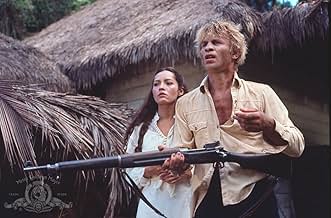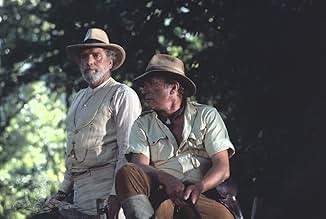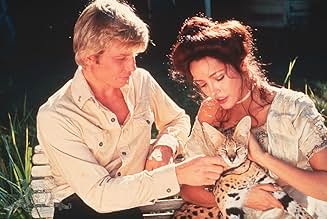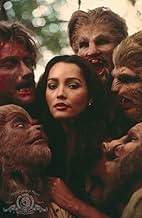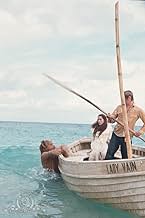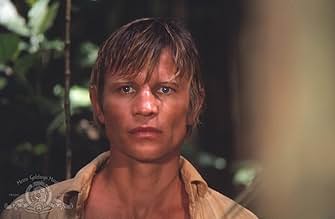IMDb RATING
5.9/10
7.7K
YOUR RATING
A shipwrecked survivor discovers a remote island owned by a crazed scientist who is carrying out sinister experiments on the island's inhabitants.A shipwrecked survivor discovers a remote island owned by a crazed scientist who is carrying out sinister experiments on the island's inhabitants.A shipwrecked survivor discovers a remote island owned by a crazed scientist who is carrying out sinister experiments on the island's inhabitants.
- Awards
- 6 nominations total
Featured reviews
My friend and I rented The Island of Dr. Moreau (1977). We both enjoyed it and thought the make-up was outstanding. There is some good acting and the story was close to Wells's novel. The remake was awful. This one is much better, so if you want to see a good science fiction movie rent this one. You won't be dissapointed. 7 out of 10.
Especially if you don't know what this movie is about before you're going to watch it, you'll be gripped by its mysterious and tense build up.
To be frank, this movie has one of the best and most tense story build ups I have seen in a long time. For a long time it remains unclear what exactly is going on and what the movie will be about. As the movie progresses the movie does loose some of its power and tension, when it falls into some obvious clichés and formulaic genre elements, plus some just plain odd and poorly done sequences. But all is forgiven. All in all this version of the H.G. Wells remains a well done one, with plenty of enough tense and mysterious moments in it, which absolutely makes this movie distinct itself from other genre movies. In a way the movie and its build up and atmosphere really reminded me of "Planet of the Apes (1968)"
The build up and atmosphere is amazing in the first halve. It doesn't use any fancy tricks but leaves lots of things up to the viewers own imagination. The second halve is however quite different and in fact is nothing more than a typical genre piece from the '70's. Everything gets explained but at the same time everything also is far from believable. The horror/monster elements are hardly refreshing or new and in a way degrade the story- and the movie in general. It definitely makes the second halve of the movie not as good as the first but the first halve builds up so many things in a great way, that the second halve can't really ruin it that much. "The Island of Dr. Moreau" at all times remains a perfectly good watchable movie that is unique and a standout in its genre.
Burt Lancaster does a good job at keeping his role simple and mysterious. Michael York works out way better as the main hero than you at first would expect.
The settings are nice and so is the rest of the visual look. The make-up effects might look perhaps a bit outdated in todays perspective but they're actually quite above par. Also the musical score from Laurence Rosenthal is surprising great and works effective in the movie.
Just forget the '96 version. This movie is in my opinion surprisingly a real must-see!
8/10
http://bobafett1138.blogspot.com/
To be frank, this movie has one of the best and most tense story build ups I have seen in a long time. For a long time it remains unclear what exactly is going on and what the movie will be about. As the movie progresses the movie does loose some of its power and tension, when it falls into some obvious clichés and formulaic genre elements, plus some just plain odd and poorly done sequences. But all is forgiven. All in all this version of the H.G. Wells remains a well done one, with plenty of enough tense and mysterious moments in it, which absolutely makes this movie distinct itself from other genre movies. In a way the movie and its build up and atmosphere really reminded me of "Planet of the Apes (1968)"
The build up and atmosphere is amazing in the first halve. It doesn't use any fancy tricks but leaves lots of things up to the viewers own imagination. The second halve is however quite different and in fact is nothing more than a typical genre piece from the '70's. Everything gets explained but at the same time everything also is far from believable. The horror/monster elements are hardly refreshing or new and in a way degrade the story- and the movie in general. It definitely makes the second halve of the movie not as good as the first but the first halve builds up so many things in a great way, that the second halve can't really ruin it that much. "The Island of Dr. Moreau" at all times remains a perfectly good watchable movie that is unique and a standout in its genre.
Burt Lancaster does a good job at keeping his role simple and mysterious. Michael York works out way better as the main hero than you at first would expect.
The settings are nice and so is the rest of the visual look. The make-up effects might look perhaps a bit outdated in todays perspective but they're actually quite above par. Also the musical score from Laurence Rosenthal is surprising great and works effective in the movie.
Just forget the '96 version. This movie is in my opinion surprisingly a real must-see!
8/10
http://bobafett1138.blogspot.com/
... although any limitations on what could have been shown or done were much more lax in this film 44 years later. Yet I just like the original better.
This is another take on the H. G. Wells novel about the "mad" scientist experimenting with animals on a South Seas island, performing surgery on them in "the House of Pain" to try to transform them into human beings. Of course, things never go as planned in these films. Moreau is, after all, "tampering in God's domain" (though that hoary old expression is mercifully not used in this film).
Difficult to not compare this version to the first adaption, 1933's Island of Lost Souls, which I find far more satisfactory. In the original Charles Laughton brought a creepy, perverse quality to his Moreau. He was unsettling but effective, and when he cracked that whip in the "What is the law?" scene with the man beasts there was more than a hint of the sadist about him.
The surprising casting of Burt Lancaster as Moreau in the 1977 version fails to bring any of these same odious qualities to the film. It's difficult to work up much of a dislike for Lancaster's scientist in spite of his activities. He's still Burt, and he has to battle against his good guy screen persona.
Island of Dr. Moreau also surprisingly jettisons one of the kinkiest aspects of the 1933 film, the Panther Girl, as originally played by Kathleen Burke, his most near perfection human like creation from a beast, with whom Laughton's Moreau is eager to see if an unsuspecting male shipwrecked on his island (Richard Arlen) will be willing to mate.
The '77 version does have beautiful Barbara Carrera slinking around, and she certainly intrigues (well, more than intrigues) Michael York, now in the Arlen role. Lancaster is aware that they are sexually attracted to each other and ready to mate - but to what purpose, since it turns out Carrera is a normal human, and no kind of Panther Girl. There is a hint in her final scene, however, that she may not be quite so normal, after all, but it went by so quickly I wasn't quite certain if it was my imagination.
The man beasts in the original are more effective than here. For starters, you didn't get a really good look at the makeup in the original (outside of a closeup of Bela Lugosi), so much of it is left to the audience's imagination. In the '77 version you see the makeup and, to be honest, it's not so much frightening as it is artificial in appearance (on about a par with that to be found in the original Planet of the Apes).
The '77 version, however, interestingly, does show what happens to the man beasts after everything blows up on the island, something the '33 original left to our imagination. This version also has Moreau strapping down and experimenting with York, something not done in the '33 version. That is one of the more interesting aspects of this production, as well.
In the final analysis, this is a fairly mediocre adaption of the Wells story, but one should still see it to make his own assessment. There would be another version with Brando almost 20 years later, of course. It's been too long since I've seen that version to talk about it, though I do recall disliking it at the time.
This is another take on the H. G. Wells novel about the "mad" scientist experimenting with animals on a South Seas island, performing surgery on them in "the House of Pain" to try to transform them into human beings. Of course, things never go as planned in these films. Moreau is, after all, "tampering in God's domain" (though that hoary old expression is mercifully not used in this film).
Difficult to not compare this version to the first adaption, 1933's Island of Lost Souls, which I find far more satisfactory. In the original Charles Laughton brought a creepy, perverse quality to his Moreau. He was unsettling but effective, and when he cracked that whip in the "What is the law?" scene with the man beasts there was more than a hint of the sadist about him.
The surprising casting of Burt Lancaster as Moreau in the 1977 version fails to bring any of these same odious qualities to the film. It's difficult to work up much of a dislike for Lancaster's scientist in spite of his activities. He's still Burt, and he has to battle against his good guy screen persona.
Island of Dr. Moreau also surprisingly jettisons one of the kinkiest aspects of the 1933 film, the Panther Girl, as originally played by Kathleen Burke, his most near perfection human like creation from a beast, with whom Laughton's Moreau is eager to see if an unsuspecting male shipwrecked on his island (Richard Arlen) will be willing to mate.
The '77 version does have beautiful Barbara Carrera slinking around, and she certainly intrigues (well, more than intrigues) Michael York, now in the Arlen role. Lancaster is aware that they are sexually attracted to each other and ready to mate - but to what purpose, since it turns out Carrera is a normal human, and no kind of Panther Girl. There is a hint in her final scene, however, that she may not be quite so normal, after all, but it went by so quickly I wasn't quite certain if it was my imagination.
The man beasts in the original are more effective than here. For starters, you didn't get a really good look at the makeup in the original (outside of a closeup of Bela Lugosi), so much of it is left to the audience's imagination. In the '77 version you see the makeup and, to be honest, it's not so much frightening as it is artificial in appearance (on about a par with that to be found in the original Planet of the Apes).
The '77 version, however, interestingly, does show what happens to the man beasts after everything blows up on the island, something the '33 original left to our imagination. This version also has Moreau strapping down and experimenting with York, something not done in the '33 version. That is one of the more interesting aspects of this production, as well.
In the final analysis, this is a fairly mediocre adaption of the Wells story, but one should still see it to make his own assessment. There would be another version with Brando almost 20 years later, of course. It's been too long since I've seen that version to talk about it, though I do recall disliking it at the time.
Based on the excellent novel by renowned science fiction author H.G. Wells, this watchable and updated remake of the 1933 film starring Charles Laughton plays on the Frankenstein theme where man attempts to play God and improve upon Mother Nature. Andrew Braddock (Michael York) is a castaway of a shipwreck who serendipitously lands on an isolated island in the Pacific, and becomes the guest of the main inhabitant, Dr Moreau who appears seemingly hospitable enough at first. His other companions are ex-mercenary Montgomery (Nigel Davenport), and a beautiful yet emotionally distant woman Maria (Barbara Carrera),whom the doctor claims to have rescued from poverty from another country and brought up as his ward. Braddock's stay is normal albeit boring at first (not really much to do on an isolated island, is there?), then he begins to notice that things are not what they seem - the strange animal sounds that emanate from the forest at night, and the weird facial features of the servants who wait upon the doctor. His worst fears are confirmed when he encounters the results of the doctor's experiments - upright hairy creatures (who look like variations of the Wolfman of the old horror movies) that appear human and yet are not exactly men, though they wear clothing and can speak. He realizes that Dr Moreau is a madman doing modern Frankenstein-type experiments by messing up with the DNA of humans and animals, with Montgomery as a contemporary Igor - how the doctor obtains and maintains sterility of his concoctions and instruments without the benefit of refrigeration or sterilization in such primitive conditions is a moot point.
When Braddock protests at the cruel treatment of the creatures, Dr Moreau attempts to justify his experiments by explaining that by doing so, humanity would be benefited by elimination of birth defects and such, but Braddock is unconvinced.
Though they are repulsive-looking in appearance, the viewer can't help but sympathize with the plight of the "manimals", who live together in squalor in a dark cave, kept in line by The Laws established by Moreau - do not kill, do not shed blood, do not walk on all fours, etc. - repeated on an almost daily basis by their apparent leader the Sayer of the Law (Richard Baseheart), who looks the most "human" and "civilized" of the lot. Infractions of the Law results in being brought to the so-called House of Pain, where Moreau attempts to "correct" the miscreant and remind him that he is human and not animal.
The turning point in the film is when the Bullman (obviously originally a bison by the presence of a hairy hump on his back), having broken the law of shedding blood, attempts to flee rather than face punishment and is gunned down by Braddock. Yet despite having broken the law against killing, Braddock goes apparently unpunished, establishing in the minds of the other man-beasts of the unfairness of the Law - they seem to ask silently, why can this man kill and go scot-free and we can't?, and the eventual murder of Montgomery at the hands of Dr Moreau himself reinforces the double-standards of The Law in their eyes, and they eventually rise and revolt against the doctor, killing him, destroying the compound in which he lives in and setting it on fire. Ironically, it is this very act of staging a collective uprising which brings out the "humanity" of the creatures, as it shows that they can after all, think and plan and not merely act on their basic instincts, as the scenes where they suspend the doctor on a rope and systematically destroy the House of Pain and release the captive animals show. So in a way, Dr Moreau's experiments were not a total failure as he thought, they just didn't turn out the way he anticipated.
When Braddock protests at the cruel treatment of the creatures, Dr Moreau attempts to justify his experiments by explaining that by doing so, humanity would be benefited by elimination of birth defects and such, but Braddock is unconvinced.
Though they are repulsive-looking in appearance, the viewer can't help but sympathize with the plight of the "manimals", who live together in squalor in a dark cave, kept in line by The Laws established by Moreau - do not kill, do not shed blood, do not walk on all fours, etc. - repeated on an almost daily basis by their apparent leader the Sayer of the Law (Richard Baseheart), who looks the most "human" and "civilized" of the lot. Infractions of the Law results in being brought to the so-called House of Pain, where Moreau attempts to "correct" the miscreant and remind him that he is human and not animal.
The turning point in the film is when the Bullman (obviously originally a bison by the presence of a hairy hump on his back), having broken the law of shedding blood, attempts to flee rather than face punishment and is gunned down by Braddock. Yet despite having broken the law against killing, Braddock goes apparently unpunished, establishing in the minds of the other man-beasts of the unfairness of the Law - they seem to ask silently, why can this man kill and go scot-free and we can't?, and the eventual murder of Montgomery at the hands of Dr Moreau himself reinforces the double-standards of The Law in their eyes, and they eventually rise and revolt against the doctor, killing him, destroying the compound in which he lives in and setting it on fire. Ironically, it is this very act of staging a collective uprising which brings out the "humanity" of the creatures, as it shows that they can after all, think and plan and not merely act on their basic instincts, as the scenes where they suspend the doctor on a rope and systematically destroy the House of Pain and release the captive animals show. So in a way, Dr Moreau's experiments were not a total failure as he thought, they just didn't turn out the way he anticipated.
There's three principal reasons why this HG Wells' inspired horror adventure works, firstly the distinguished cast led by A-graders Michael York (as the shipwrecked engineer) and Burt Lancaster, as the reclusive title character whose gene experiments on the local animal population is resulting in terrible mutations trapped amid instincts that lay somewhere between man and animal, a precariously distorted eco-system.
Nigel Davenport plays the boozy mercenary protecting the island establishment from its own macabre experiments, while Richard Basehart is a transformed animal, human enough to be the law sayer and peace-keeper of the mutated island population. Then there's the ravishing Barbara Carrera as a naive orphan brought to the island as a child by Moreau, besotted by the chivalrous York, but equally mysterious like her young lynx companion. Nick Cravat and Dave Cass have minor supporting roles as manimals of various pedigree.
The second reason to tune in is the set design and make-up effects in which luminaries John Chambers and Dan Striepeke were involved. Moreau's half-breed experiments are impressively brought to life by Chambers' crew, the full effect more evident on close-up, particularly on the unrecognisable Basehart.
Finally, if it needs to be defended, the production of Samuel Z.Arkoff and Sandy Howard should please some, their AIP distribution lending a certain B-movie prestige, a badge that will in itself, attract a legion of fans (but equally, render others suspicious of the quality). Overall, while there were a plethora of plot-holes to be found, and the conclusion a little simplistic, the general tone and quality of the film remained highly entertaining, uncomplicated and straightforward, something the 1996 remake couldn't muster in spite of its (by relative standards) gold plated production.
Nigel Davenport plays the boozy mercenary protecting the island establishment from its own macabre experiments, while Richard Basehart is a transformed animal, human enough to be the law sayer and peace-keeper of the mutated island population. Then there's the ravishing Barbara Carrera as a naive orphan brought to the island as a child by Moreau, besotted by the chivalrous York, but equally mysterious like her young lynx companion. Nick Cravat and Dave Cass have minor supporting roles as manimals of various pedigree.
The second reason to tune in is the set design and make-up effects in which luminaries John Chambers and Dan Striepeke were involved. Moreau's half-breed experiments are impressively brought to life by Chambers' crew, the full effect more evident on close-up, particularly on the unrecognisable Basehart.
Finally, if it needs to be defended, the production of Samuel Z.Arkoff and Sandy Howard should please some, their AIP distribution lending a certain B-movie prestige, a badge that will in itself, attract a legion of fans (but equally, render others suspicious of the quality). Overall, while there were a plethora of plot-holes to be found, and the conclusion a little simplistic, the general tone and quality of the film remained highly entertaining, uncomplicated and straightforward, something the 1996 remake couldn't muster in spite of its (by relative standards) gold plated production.
Did you know
- TriviaDuring the fight between the bullman and the tiger, the animal actually took the stuntman's head in his jaws. Luckily he was wearing a fiberglass helmet which protected him.
- GoofsDuring the opening scene when the boat is being pushed ashore you can see the shadow of the boom mic in the water's edge.
- Quotes
Sayer of the Law: [about Moreau] His is the hand that makes. His is the hand that hurts. His is the hand that heals. His is the House of Pain. His is the House of Pain. His is the House of Pain. He who breaks the law shall be punished back to the House of Pain.
- ConnectionsFeatured in A Century of Science Fiction (1996)
- SoundtracksDer Vogelfänger bin ich ja
(Papageno's Aria from "Die Zauberflöte" K.620)
Written by Wolfgang Amadeus Mozart
Details
- Release date
- Country of origin
- Official site
- Language
- Also known as
- Die Insel des Dr. Moreau
- Filming locations
- St. Croix, U.S. Virgin Islands(location)
- Production companies
- See more company credits at IMDbPro
Box office
- Budget
- $6,000,000 (estimated)
Contribute to this page
Suggest an edit or add missing content

Top Gap
By what name was The Island of Dr. Moreau (1977) officially released in India in English?
Answer

